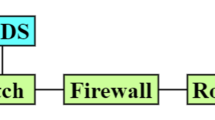Abstract
Due to massive data flow and complexity of changeable data characteristics, the dimension disasters problems is ordinary existed in the prediction of the Distributed Denial of Services (DDoS) large-flow attack for multimedia Internet of Things, which will result in the following deficiency such as excessive consumption of computing, and storage resources, reduced analysis efficiency. In this paper, a novel method with the combination of matrix diversity and principal component analysis is proposed for DDoS feature reduction. Firstly, matrix diversity is used to reduce the multiple feature properties of DDoS, and then principal component analysis is used to reduce these features further. Then, the statistical characteristics of these correlations are analyzed. Finally, real-time attack detection is carried out based on mahalanobis distance (MD). It is obvious demonstrated that the proposed method has higher prediction accuracy and more computational efficiency than the traditional method.






Similar content being viewed by others
References
Bhuyan MH, Bhattacharyya DK, Kalita J (2014) Network anomaly detection: methods, systems and tools. International Symposium on MobiHoc 16(1):303–336
Bouzida Y, Cuppens F, Cuppens N et al (2003) Efficient intrusion detection using principal component analysis. In: Proceedings of world multi-conference on systems cybernetics & informatics, pp 235–235
Chen RC, Cheng KF, Chen YH et al (2009) Using rough set and support vector machine for network intrusion detection systems. In: First Asian conference on intelligent information and database systems. IEEE, pp 465–470
Gu P, Hua C, Khatoun R et al (2018) Cooperative relay beamforming for control channel jamming in vehicular networks. In: International symposium on modeling and optimization in mobile, ad hoc, and wireless networks, pp 1–7
Hai TN, Franke K (2013) Adaptive intrusion detection systems via online machine learning. In: International conference on hybrid intelligent systems. IEEE, pp 271–277
Kausar N, Samir BB, Sulaiman SB et al (2012) An approach towards intrusion detection using PCA feature subsets and SVM. In: International conference on computer & information science. IEEE, pp 569–574
Kayacik HG, Zincir AN, Heywood M (2005) Selecting features for intrusion detection: a feature relevance analysis on KDD 99 intrusion detection datasets. In: Conference on privacy, pp 201–210
Kuncheva LI, Rodriguez JJ (2007) Classifier ensembles with a random linear oracle. IEEE Trans Knowl Data Eng 19(4):500–508
Kuncheva LI, Rodriguez JJ (2007) An experimental study on rotation forest ensembles. In: International workshop on multiple classifier systems. Springer, Berlin, pp 459–568
Lee W, Stolfo SJ, Mok KW (1999) A data mining framework for building intrusion detection models. In: Proceedings of 1999 IEEE symposium on security and privacy. IEEE, pp 120–132
Mishra A, Nadkarni K, Patcha A (2014) Intrusion detection in wireless ad hoc networks. IEEE Wirel Commun 11(1):48–60
Moore D, Voelker G, Savage S (2006) Inferring internet denial-of-service activity. ACM Trans Comput Syst 24(2):115–139
Osanaiye O, Choo KKR, Dlodlo M (2016) Distributed denial of services (DDoS) resilience in cloud: review and conceptual cloud DDoS mitigation framework. J Netw Comput Appl 67:147–165
Qin A, Shao L (2012) Method on rule extracting in misuse intrusion detection based on rough set genetic algorithm. In: 7th international conference on computing and convergence technology. IEEE, pp 731–734
Sharma A, Pujari AK, Paliwal KK (2007) Intrusion detection using text processing techniques with a kernel based similarity measure. J Netw Comput Appl 26(7–8):488–495
Tsang CH, Kwong S, Wang H (2007) Genetic fuzzy rule mining approach and evaluation of feature selection techniques for anomaly intrusion detection. Pattern Recogn 40(9):2373–2391
Tumer K, Ghosh J (1998) Ensembles of radial basis function networks for spectroscopic detection of cervical precancer. IEEE Trans Biomed Eng 45(8):953–961
Xu W, Trappe W, Zhang Y et al (2005) The feasibility of launching and detecting jamming attacks in wireless networks. In: Proceedings of 6th ACM international symposium on mobile ad hoc network and computing. ACM, pp 46–47
Acknowledgments
The research is supported by grant 2016YFB0800700 from the National Key Research and Development Program of China.
Author information
Authors and Affiliations
Corresponding author
Additional information
Publisher’s note
Springer Nature remains neutral with regard to jurisdictional claims in published maps and institutional affiliations.
Rights and permissions
About this article
Cite this article
Zong, Y., Huang, G. A feature dimension reduction technology for predicting DDoS intrusion behavior in multimedia internet of things. Multimed Tools Appl 80, 22671–22684 (2021). https://doi.org/10.1007/s11042-019-7591-7
Received:
Revised:
Accepted:
Published:
Issue Date:
DOI: https://doi.org/10.1007/s11042-019-7591-7




